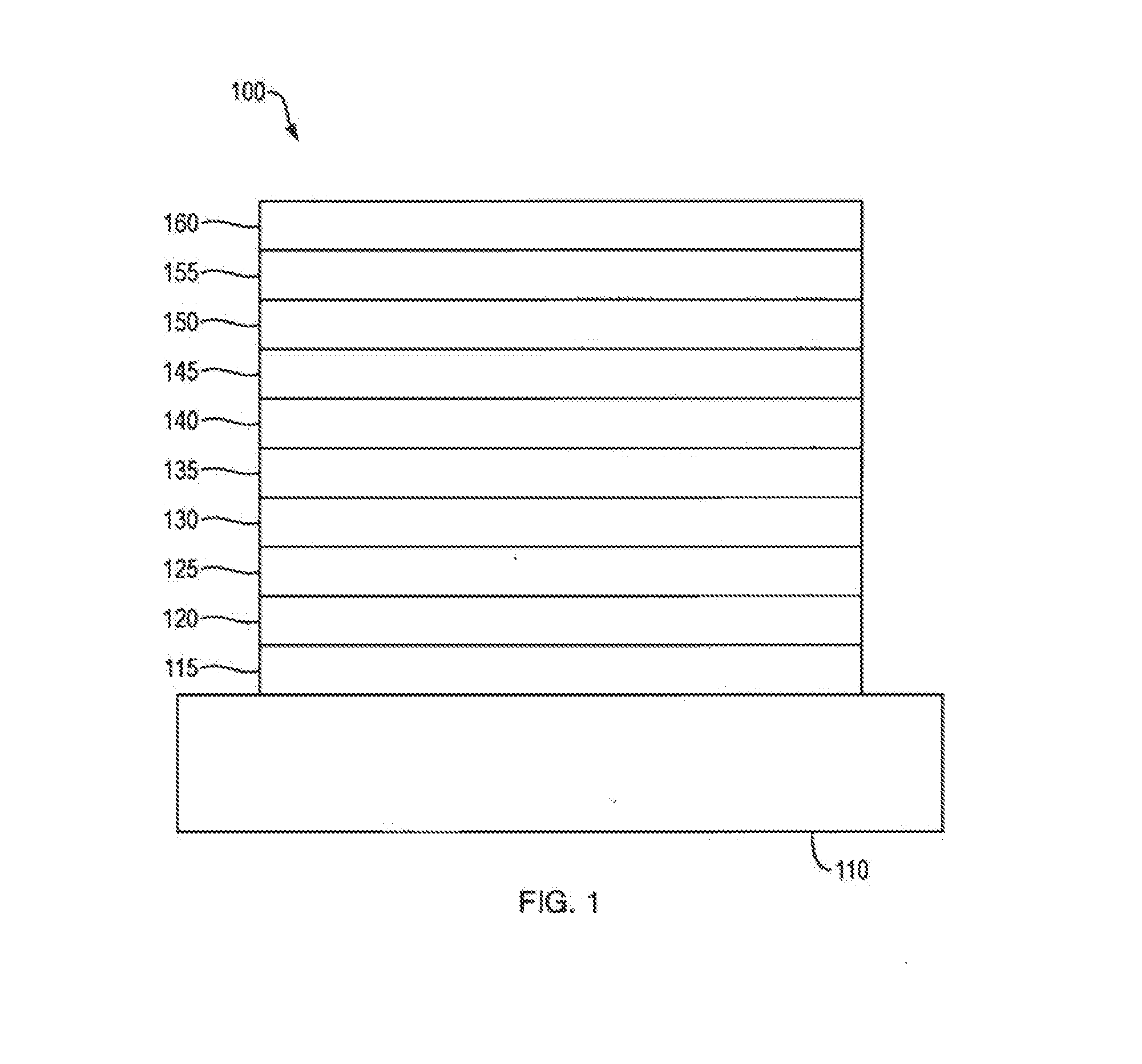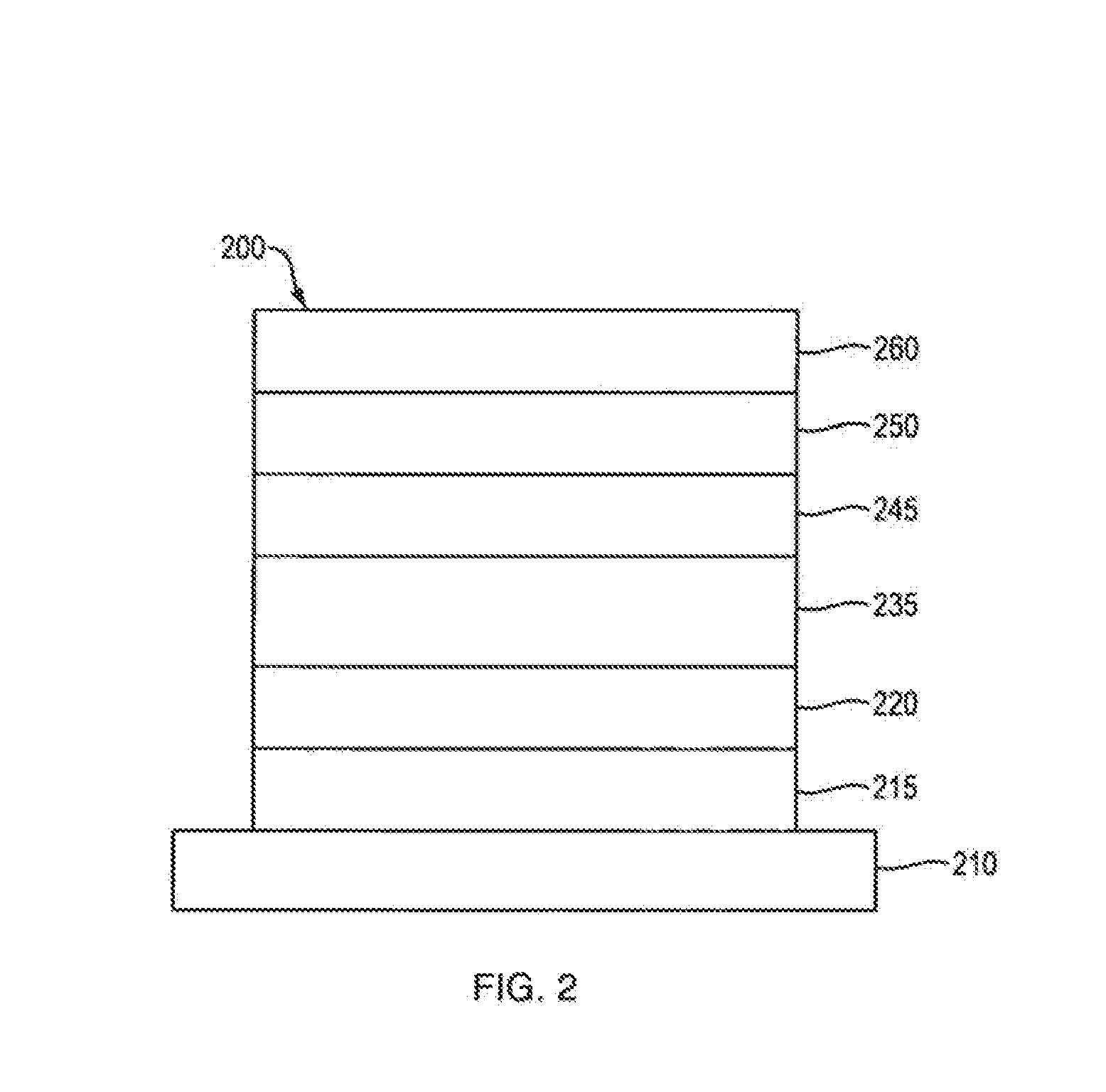Organic electroluminescent materials and devices
a technology of electroluminescent materials and devices, applied in the field of new compounds, can solve problems such as non-radiative mechanisms
- Summary
- Abstract
- Description
- Claims
- Application Information
AI Technical Summary
Benefits of technology
Problems solved by technology
Method used
Image
Examples
example 1
[0192]Synthesis of 3,4-dihydrodibenzo[b,ij]imidazo[2,1,5-de]quinolizine was prepared in accordance with Scheme 1.
A. Synthesis of 4-chlorobutanal
[0193]
[0194]A solution of oxalyl chloride (22.54 ml, 263 mmol) in DCM (400 ml) was cooled in an iPrOH / CO2 bath. DMSO (37.3 ml, 525 mmol) was slowly via syringe and stirred cold for 1 hour. A solution of 4-chlorobutan-1-ol (19 g, 175 mmol) in 50 mL DCM was added dropwise. The col mixture was stirred for one hour, then, triethylamine (110 ml, 788 mmol) was slowly added. The suspension was stirred cold for 30 minutes, then allowed to warm to room temperature. The reaction was quenched with water, acidified and organics separated. Solvent removal followed by distillation yielded the product as a colorless oil, 8 g.
B. Synthesis of 2-bromo-4-chlorobutanal
[0195]
[0196]4-chlorobutanal (7.939 g, 74.5 mmol) was dissolved in DCM (300 ml) and cooled in an ice bath. A solution of dibromine (4.00 ml, 78 mmol) in DCM (50 ml) was added over about 1 hr. After...
example 2
Synthesis of 4,4-dimethyl-3,4-dihydro-1,2a1-diaza-4-silabenzo[fg]aceanthrylene and 3,3-dimethyl-3,4-dihydro-1,2a1-diaza-3-silabenzo[fg]aceanthrylene
[0204]
[0205]The ligands above are prepared in accordance with Scheme 2 below.
A. Synthesis of 5-bromoimidazo[1,2-f]phenanthridine
[0206]
[0207]4-bromophenanthridin-6-amine (4.0 g, 14.7 mmol) was dissolved in 100 mL of iPrOH. Chloroacetaldehyde (50% in water, 3.6 g, 22 mmol, 1.5 equiv.) was added, followed by NaHCO3 (2.5 g, 2 equiv.), and the mixture was refluxed for 2 hours, then cooled in an ice bath. The tan solid was filtered off, washing with MeOH. The receiving flask was changed and the solid was washed with water, resulting in clean, off-white product, 3.2 g. The aqueous washes were extracted with EtOAc and these extracts were combined with the alcoholic washes from the initial filtration. Solvent was removed to yield 1.3 g of an orange solid which was recrystallized from EtOAc, yielding more clean product as tan needles, 0.46 g. Tota...
example 3
Synthesis of platinum(II) complex of 6-isopropyl-10-((9-(4-isopropylpyridin-2-yl)-9H-carbazol-2-yl)oxy)-3,4-dihydrodibenzo[b,ij]imidazo[2,1,5-de]quinolizine
[0215]
A. Synthesis of 2-Bromo-5-methoxybenzonitrile
[0216]
[0217]A mixture of 2-bromo-5-methoxybenzaldehyde (100 g, 0.47 mol, 1 equiv), hydroxylamine hydrochloride (64.8 g, 0.93 mol, 2 equiv), sodium acetate (76.42 g, 0.93 mol, 2 equiv) and glacial acetic acid (500 mL) was refluxed overnight. The acetic acid was removed under reduced pressure and the residue was extracted with dichloromethane (˜400 mL). The organic layer was washed with saturated brine (3×200 mL), dried over sodium sulfate and concentrated under reduced pressure. The resulting residue was triturated with heptanes (50 mL) and solids washed with additional heptanes (2×50 mL) to give the desired product as a white powder (82.6 g, 86% yield)
B. Synthesis of 5-Methoxy-2-(4,4,5,5-tetramethyl-1,3,2-dioxaborolan-2-yl)benzonitrile
[0218]
[0219]A mixture of 2-bromo-5-methoxyben...
PUM
 Login to View More
Login to View More Abstract
Description
Claims
Application Information
 Login to View More
Login to View More - R&D
- Intellectual Property
- Life Sciences
- Materials
- Tech Scout
- Unparalleled Data Quality
- Higher Quality Content
- 60% Fewer Hallucinations
Browse by: Latest US Patents, China's latest patents, Technical Efficacy Thesaurus, Application Domain, Technology Topic, Popular Technical Reports.
© 2025 PatSnap. All rights reserved.Legal|Privacy policy|Modern Slavery Act Transparency Statement|Sitemap|About US| Contact US: help@patsnap.com



